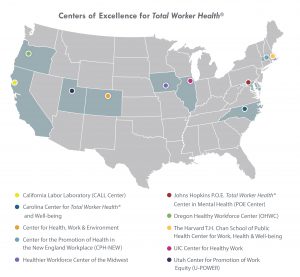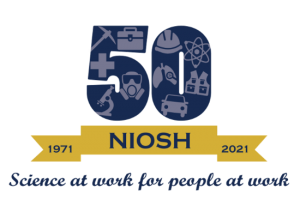Total Worker Health Program Readies NIOSH for Next 50 Years
Posted on by
As NIOSH commemorates its 50th anniversary, the NIOSH Total Worker Health® Program reflects on its past while focusing on leading the field of occupational safety and health into the future. The past and current successes of the Total Worker Health discipline are rooted in the fundamental beliefs that work and workplaces should be safe and healthy, that it is unacceptable to trade a worker’s health for wages, and that protections should extend to all workers regardless of industry, occupation, job title, or status of employment. Centered in the approach is the belief that work should be an ongoing, enriching source of well-being for workers, their families, and communities.
Total Worker Health (TWH) is defined as policies, programs, and practices that integrate protection from work-related safety and health hazards with promotion of injury and illness prevention efforts to advance worker well-being. This approach prioritizes a hazard-free work environment for all workers. It also brings together all aspects of work in integrated interventions that collectively address worker safety, health, and well-being.
Initiatives that Led to “Total Worker Health”
The TWH approach originates from the 2003 NIOSH Steps to a Healthier US Workforce Initiative. Following the 2004 Steps to a Healthier US Workforce Symposium, NIOSH developed a new NIOSH WorkLife Initiative in 2005, which sought to improve overall worker health through better work-based programs, policies, practices, and benefits. In 2011, NIOSH renamed “WorkLife” to the Total Worker Health® Program, committed to developing knowledge focused on integration of occupational safety and health protection and health promotion.
An Expanding Evidence Base
Foundational publications, workshops, and research programs helped build the evidence base for an integrated, holistic approach to worker well-being. The Research Compendium: The NIOSH Total Worker Health Program: Seminal Research Papers 2012 presented the rationale for the TWH approach. In 2014, the TWH program partnered with the Institute of Medicine to share advances in TWH science, hosting a workshop on “Best and Promising Practices in TWH,” and coordinating the 1st International Symposium to Advance TWH. The 2nd International Symposium to Advance TWH followed in 2018 and the 3rd International Symposium to Advance TWH is scheduled for October 11–14, 2022.
Defining elements of the approach are identified in the Fundamentals of Total Worker Health® Approaches: Essential Elements for Advancing Worker Safety, Health, and Well-being, published in 2016. In 2019, the first ever edited volume on Total Worker Health was published. As the TWH scientific evidence base grows over the next 50 years, and more intervention approaches and strategies find their way into practice, NIOSH will work to see TWH concepts more widely adopted across the nation.
Partners Critical to Success
From the earliest days of the program, partnerships have been essential to the growth of the evidence base and the translation of knowledge into effective prevention practices. Currently, the TWH program has research agreements with 10 Centers of Excellence for TWH. Established in 2005, the Centers are hubs for TWH-related research and practice and help develop new solutions for complex occupational safety and health problems.
The NIOSH TWH Affiliate Program also advances worker safety, health, and well-being through non-funded collaborations with governmental and nonprofit organizations, including labor, education, training, and research organizations. Established in 2014, the program reached a milestone of more than 50 affiliates in 2021.
Evolving to Meet the Emerging Needs of Workers and Workplaces
Over the years, the TWH program expanded within NIOSH to address evolving challenges and opportunities related to worker safety, health, and well-being. In 2015, the TWH program celebrated the launch of the National Center for Productive Aging and Work to address the needs of an aging workforce. The program also collaborated with other NIOSH efforts that use the TWH framework, including Healthy Work Design and Well-being Cross Sector Program, Opioids in the Workplace, the NIOSH Future of Work Initiative, and the new initiative focused on protecting health worker mental health. In late 2021, the program named the first-ever Center of Excellence for TWH solely dedicated to workplace mental health. This Center, located at Johns Hopkins School of Public Health, will conduct vital research and outreach activities to address one of the most challenging aspects of today’s quickly changing world of work.
Vision for the Future
The 50th anniversary of NIOSH offers an opportunity for reflection and optimism. The TWH program envisions work that enhances all aspects of daily life, thinking beyond the concept as work as merely a means of survival, to envision work as a way to provide meaning, fulfillment, and improved health and well-being. To move the field of occupational safety and health forward, the program works to better define, measure, and operationalize the concept of well-being in the context of work. The NIOSH Worker Well-Being Questionnaire (WellBQ), published in 2021, will help identify workplace and work elements that diminish (or add to) health, leading to even sounder interventions to address these elements.
In addition, TWH science aims to prepare employers and workers to take on the challenges of a rapidly evolving economy, innovative but demanding technologies, and new employment patterns, while helping workers maintain a significant voice and influence on these changes. Organizations that empower and nurture the safest and healthiest workers will be the ones most likely to succeed over the long-term.
In the next 50 years, TWH will bring greater attention to the diverse needs of working families, offer new strategies to inspire meaningful work, explore ways to improve human connections and social cohesion through work, and uncover new pathways to well-being even as work and employment dramatically change.
For more information on TWH, visit the website or subscribe to the newsletter, Total Worker Health in Action!
L. Casey Chosewood, MD, MPH, is the director of the NIOSH Office for Total Worker Health®.
 Emily Kirby, BPH, is a Health Communication Specialist in the NIOSH Office of Communication and Research to Practice.
Emily Kirby, BPH, is a Health Communication Specialist in the NIOSH Office of Communication and Research to Practice.
This blog is part of a series for the NIOSH 50th Anniversary. Stay up to date on how we’re celebrating NIOSH’s 50th Anniversary on our website.
Posted on by

